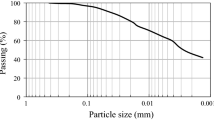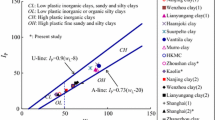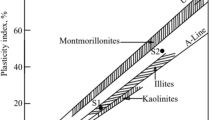Abstract
Soft soil subjected to cyclic loading typically exhibits an increase in excess pore pressure under undrained condition which brings the soil to an overconsolidated state. Then, under a subsequent large number of cycles (e.g. more than one million) which also takes time, the creep at overconsolidated state influences the cyclic effect and thus results in a complicated long-term undrained behavior. This paper aims to clarify this long-term undrained behavior of overconsolidated clay. The reconstituted samples are prepared from natural samples retrieved in the north of France. First, the shear strength characteristics along monotonic triaxial stress paths are identified. Then load control cyclic tests on overconsolidated specimens are conducted in fully saturated and undrained conditions. Small cyclic deviatoric stresses are applied in order to investigate more particularly the behavior under a very large number of cycles, during which an unusual pore pressure evolution is observed. To explain this, undrained triaxial creep tests are performed on reconstituted specimens with different values of OCRs under some specified stress states. The evolutions of axial strain, excess pore pressure, stress ratio, stress path, plastic strain rates and stress dilatancy during undrained creep are discussed. The additional undrained creep tests also show that two processes are simultaneously acting in a competitive manner: increase in the pore pressure due to the cyclic loading and decrease in the pore pressure because of creep.














Similar content being viewed by others
References
Adachi T, Oka F (1982) Constitutive equations for normally consolidated clay based on elasto-viscousplasticity. Soils Found 22(4):57–70
Andersen KH (1988) Properties of soft clay under static and cyclic loading. In: International Conference on Engineering Problems of Regional soils. Beijing, China. Proceeding, pp 7–26
Andersen KH (2004) Cyclic clay data for foundation design of structures subjected to wave loading. In: Proceedings of the international conference on “cyclic behaviour of soils and liquefaction phenomena”, Bochum, Germany, pp 371–387
Andersen KH, Pool JH, Brown SF, Rosenbrand WF (1980) Cyclic and static laboratory tests on Drammen clay. J Geotech Eng 106(GT5):499–529
Arulanandan K, Shen CK, Young RB (1971) Undrained creep behavior of a coastal organic silty clay. Géotechnique 21(4):359–375
Biarez J, Hicher PY (1994) Elementary mechanics of soil behaviour: saturated remoulded soils. A.A.Balkema Publishers, Rotterdam
Boulanger RW, Idriss IM (2006) Liquefaction susceptibility criteria for silts and clays. J Geotech Geoenviron Eng 132(11):1413–1426
Burland JB (1990) On the compressibility and shear strength of natural soils. Géotechnique 40(3):329–378
Cai Y, Gu C, Wang J, Juang C, Xu CJ, Hu XQ (2013) One-way cyclic triaxial behavior of saturated clay: comparison between constant and variable confining pressure. J Geotech Geoenviron Eng 139(5):797–809
Hicher PY (1979) Contribution à l’étude de la fatigue des argiles. Ph.D., thesis, Ecole Centrale de Paris, France (in French)
Hinchberger SD (1996) The behaviour of reinforced and unreinforced embankments on rate sensitive clayey foundations. Ph.D., thesis at University of Western Ontario, Canada
Holzer TL, Hoeg K, Arulanandan K (1973) Excess pore pressure during undrained clay creep. Can Geotech J 10(12):12–24
Hyodo M, Yamamoto Y, Sugiyama M (1994) Undrained cyclic shear behaviour of normally consolidated clay subjected to initial static shear stress. Soils Found 34(4):1–11
Josseaume H, Hieng IO, Stempfelet JP (1991) Détermination des paramètres de compressibilité d’une argile raide à partir d’essais oedométriques à haute pression. Bulletin de LCPC, pp 109–120 (in French)
Li T, Meissner H (2002) Two-surface plasticity model for cyclic undrained behavior of clays. J Geotech Geoenviron Eng 128(7):613–626
Mortezaie A, Vucetic M (2016) Threshold shear strains for cyclic degradation and cyclic pore water pressure generation in two clays. J Geotech Geoenviron Eng 142(5):04016007. https://doi.org/10.1061/(ASCE)GT.1943-5606.0001461
Qian JG, Wang YG, Yin ZY, Huang MS (2016) Experimental identification of plastic shakedown behavior of saturated clay subjected to traffic loading with principal stress rotation. Eng Geol 214:29–42
Qian JG, Du ZB, Yin ZY (2018) Cyclic degradation and non-coaxiality of soft clay subjected to pure rotation of principal stress directions. Acta Geotech 13(4):943–959
Tavenas F, Leroueil S, La-Rochelle P, Roy M (1978) Creep behavior of an undisturbed lightly overconsolidated clay. Can Geotech J 15(3):402–423
Vaid YP, Campanella RG (1977) Time-dependent behaviour of undisturbed clay. J Geotech Eng 103(7):693–709
Vucetic M, Dobry R (1988) Degradation of marine clays under cyclic loading. J Geotech Eng 114(2):133–149
Walker LK (1969) Undrained creep in a sensitive clay. Géotechnique 19(4):515–529
Wang LZ, Yin ZY (2015) Stress-dilatancy of natural soft clay under undrained creep condition. Int J Geomech 15(5):1–5
Yao YP, Hou W, Zhou AN (2009) UH model: three-dimensional unified hardening model for overconsolidated clays. Géotechnique 59(5):451–469
Yao YP, Kong LM, Zhou AN, Yin JH (2015) Time-dependent unified hardening model: three-dimensional elastoviscoplastic constitutive model for clays. J Eng Mech 141(6):1–18
Yin ZY, Hicher PY (2008) Identifying parameters controlling soil delayed behaviour from laboratory and in situ pressuremeter testing. Int J Numer Anal Methods Geomech 32(12):1515–1535
Yin JH, Zhu JG, Graham J (2002) A new elastic viscoplastic model for time-dependent behaviour of normally and overconsolidated clays: theory and verification. Can Geotech J 39(1):157–173
Yin ZY, Chang CS, Karstunen M, Hicher PY (2010) An anisotropic elastic viscoplastic model for soft soils. Int J Solids Struct 47(5):665–677
Yin ZY, Xu Q, Chang CS (2013) Modeling cyclic behavior of clay by micromechanical approach. J Eng Mech 139(9):1305–1309
Yin ZY, Yin JH, Huang HW (2014) Rate-dependent and long-term yield stress and strength of soft Wenzhou marine clay: experiments and modeling. Mar Georesour Geotechnol. https://doi.org/10.1080/1064119X.2013.797060
Zhao D, Hattab M, Yin ZY, Hicher PY (2019) Dilative behavior of kaolinite under drained creep condition. Acta Geotech 14(4):1–17. https://doi.org/10.1007/s11440-018-0686-x
Acknowledgements
This research was financially supported by the Research Grants Council (RGC) of Hong Kong Special Administrative Region Government (HKSARG) of China (Grant Nos.: 15217220, R5037-18F).
Author information
Authors and Affiliations
Corresponding author
Additional information
Publisher's Note
Springer Nature remains neutral with regard to jurisdictional claims in published maps and institutional affiliations.
Appendix: Determination of plastic strain rates
Appendix: Determination of plastic strain rates
The undrained triaxial condition implies null volumetric strain \( \left( {{\text{d}}\varepsilon_{\text{a}} + 2{\text{d}}\varepsilon_{\text{r}} = 0} \right) \). Thus, during undrained creep the incremental deviatoric strain can be obtained:
Because of the null change of the deviatoric stress during undrained creep test, the elastic deviatoric strain increment is null. Therefore, Eq. (A1) can be used for the incremental plastic deviatoric strain.
The null volumetric strain condition also implies the relationship “dε pν = − dε pν ” between plastic and elastic volumetric strains. Thus, the increment of plastic volumetric strain can be obtained by the change of mean effective stress due to the generation of excess pore pressure (dp′ =− du), as follows:
with the bulk modulus \( K = \left( {1 + e_{0} } \right)p^{{\prime }} /\kappa \) and \( p^{{\prime }} = p_{0} + \Delta q/3 - \Delta u \).
Rights and permissions
About this article
Cite this article
Han, J., Yin, ZY., Dano, C. et al. Cyclic and creep combination effects on the long-term undrained behavior of overconsolidated clay. Acta Geotech. 16, 1027–1041 (2021). https://doi.org/10.1007/s11440-020-01078-5
Received:
Accepted:
Published:
Issue Date:
DOI: https://doi.org/10.1007/s11440-020-01078-5




